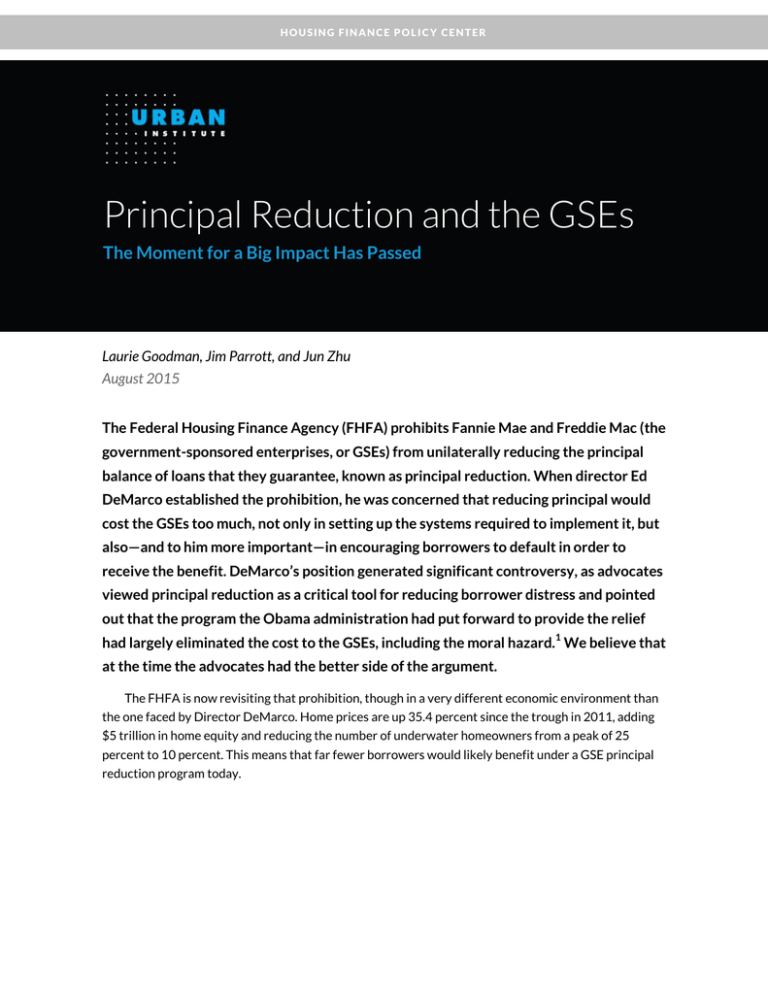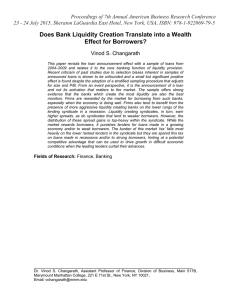Principal Reduction and the GSEs
advertisement

HOUSING FINANCE POLICY CENTER Principal Reduction and the GSEs The Moment for a Big Impact Has Passed Laurie Goodman, Jim Parrott, and Jun Zhu August 2015 The Federal Housing Finance Agency (FHFA) prohibits Fannie Mae and Freddie Mac (the government-sponsored enterprises, or GSEs) from unilaterally reducing the principal balance of loans that they guarantee, known as principal reduction. When director Ed DeMarco established the prohibition, he was concerned that reducing principal would cost the GSEs too much, not only in setting up the systems required to implement it, but also—and to him more important—in encouraging borrowers to default in order to receive the benefit. DeMarco’s position generated significant controversy, as advocates viewed principal reduction as a critical tool for reducing borrower distress and pointed out that the program the Obama administration had put forward to provide the relief had largely eliminated the cost to the GSEs, including the moral hazard.1 We believe that at the time the advocates had the better side of the argument. The FHFA is now revisiting that prohibition, though in a very different economic environment than the one faced by Director DeMarco. Home prices are up 35.4 percent since the trough in 2011, adding $5 trillion in home equity and reducing the number of underwater homeowners from a peak of 25 percent to 10 percent. This means that far fewer borrowers would likely benefit under a GSE principal reduction program today. Identifying the Relevant Population To assess how many GSE borrowers would likely benefit from a principal reduction program, we must begin by anticipating the likely scope of the program. Though it’s hard to know for sure, we assume that the FHFA would apply at least the following requirements: Borrowers must be delinquent on their loan as of the time the program is announced. There is little economic reason to reduce the principal on loans that borrowers have shown they are able to pay. And, the FHFA will presumably not allow those who go into default after the program’s announcement to participate, to avoid encouraging borrowers who are able to pay to go into default just for the principal reduction. Borrowers must owe more on their home than it is worth. If they owe less, then they could sell their home to ease their debt burden, making the significant cost of principal reduction unnecessary. The property for which the borrower has taken out the loan must be owner-occupied. The FHFA is likely to follow the lead of previous policymakers and decide not to reduce the debt burden of investors. The GSEs will only provide principal reduction on loans where doing so is in their economic interest. Writing down principal at the expense of the GSEs likely runs counter to the FHFA’s perceived mandate as conservator. These limitations help us begin to size the impact of the most likely principal reduction program. Sizing the Impact As of August 2015, Fannie Mae had 287,000 seriously delinquent loans and Freddie Mac had 161,000, 2 for a total of 448, 000 loans. This total is less than half the number of seriously delinquent loans at the end of 2011 (figure 1). Of the 448,000, 15.3 percent are underwater, and only 6.9 percent are at least 3 15 percent underwater. We note the second figure because, under the HAMP Principal Reduction Alternative, participating servicers are only required to provide principal reduction on loans that are at least 15 percent underwater, although some have chosen to provide principal reduction on loans that are less underwater. Lastly, roughly 85 percent of the loans in both categories are owner-occupied. If we assume that the principal reduction program is available only to borrowers who are delinquent and underwater, and for owner-occupied homes, we estimate that 58,000 borrowers could be eligible. If the program were to require that borrowers be at least 15 percent underwater, the universe of eligible borrowers would drop to 26,000 (table 1). 2 PRINCIPAL REDUCTION AND THE GSES FIGURE 1 Seriously Delinquent Loans Held by Fannie Mae and Freddie Mae Fannie Mae Freddie Mac Total 1,400,000 1,200,000 1,000,000 800,000 600,000 400,000 200,000 0 2010 2011 2012 2013 2014 2015 TABLE 1 Calculation of Loans Potentially Eligible for Principal Reduction Seriously delinquent (SDQ) loans Fannie Mae 287,372 Freddie Mac 160,826 Share underwater 15.29% Share 15% underwater 6.87% Total 448,198 Underwater SDQ loans Underwater 68,529 15% underwater 30,791 Owner-occupied underwater SDQ loans Share owner-occupied 85% Underwater 58,250 15% underwater 26,173 Number of loans likely to receive modification Modification rate (positive net-present-value * take up) 40% 25% 15% Underwater 23,300 14,563 8,738 15% underwater 10,469 6,543 3,926 Sources: SDQ data are from Enterprise 10-K Q2, 2015. Underwater SDQ and own-occupancy information is calculated from CoreLogic servicing data as of May 2015. CoreLogic house price index data are used to calculate month-to-month loan-to-value ratios. Modification take-up rates are calculated from Freddie Mac credit database as of May 2015 for underwater SDQ loans. PRINCIPAL REDUCTION AND THE GSES 3 The universe of eligible borrowers would be reduced further as the GSEs apply a net-present-value (NPV) assessment to identify those loans for which it would be in their economic interest to provide principal reduction. And finally, not all borrowers who are eligible for the program will ultimately participate, so one must also factor in the take-up rate to get to an estimate of likely beneficiaries. Unfortunately, we do not have enough information to estimate either the percentage of loans for which principal reduction would be NPV positive or the likely take-up rate. However, we can estimate these figures when combined, using Freddie and Fannie databases released in support of their risksharing initiatives. These databases allow us to calculate the share of loans that have been modified, which is determined by how many borrowers passed the NPV test and agreed to a modification. We then take that figure and apply it to the universe of borrowers in the delinquent, underwater, owneroccupied pool that we identified in table 1, determining how many would likely receive principal reduction. 4 To do this, we first narrow the Freddie database to loans that went at least 90 days delinquent in 5 2011–13, a universe of loans for which modification activity is largely complete. We then mark these loans to market as of the date they went 90 days delinquent, to determine which loans were underwater. From this universe of underwater, delinquent loans, we find that roughly 25 percent were modified (table 2). That is, 25 percent of borrowers were both NPV positive and agreed to accept a modification. TABLE 2 Modification Rates by Origination Year Loans that went at least 90 days delinquent in 2011–13 Origination year 2000 2001 2002 2003 2004 2005 2006 2007 2008 2009 2010 2011 2012 2013 All Underwater loans Share of underwater loans that were modified 68 527 1,086 3,103 6,134 31,562 47,726 56,605 23,458 260 24 1 1 2 24% 21% 24% 20% 24% 24% 25% 26% 28% 25% 8% 100% 100% 100% 170,557 25% Sources: Freddie Mac loan-level data as of May 2015. State-level CoreLogic house price index data are used to calculate monthto-month loan-to-value (MTMLTV) ratios. Note: MTMLTV is calculated as of the date a loan went 90 days delinquent. 4 PRINCIPAL REDUCTION AND THE GSES Now we apply this rate to our principal reduction program. If we assume that the program applies to all underwater borrowers, then a 25 percent modification rate would mean that 14,563 borrowers would receive principal reduction. If we assume that the program is only available to those more than 15 percent underwater, then the number falls to 6,543. Table 1 shows sensitivities at higher and lower modification rates. It is worth noting also that once the borrower receives a modification, success rates are quite high. For the 25 percent of 2011–13 underwater loans that received a modification, 65 percent are current. 6 For principal reduction modifications, this number could be even higher. Factors That Could Drive the Numbers Up or Down We are relatively confident that the FHFA would apply at least the requirements laid out above to any principal reduction program, and thus confident that our estimates capture the upper bound of possible eligibility. But the FHFA could add more requirements, reducing that eligible population. Several factors could also drive the modification rate of this eligible group up or down relative to rate that we’ve taken from existing programs. Principal reductions are likely to be NPV positive less frequently than other modification options, but the take-up rate may increase with the prospect of principal reduction, particularly if the FHFA were to somehow automate the program for those eligible or to transfer loan servicing to specialty servicers better equipped to get borrowers into and through the process. It is difficult to know how those differences would interact to affect the modification rate, though we would expect any variation to be modest. The modest number of borrowers likely impacted raises challenging questions of implementation. Many of the more than 1,000 GSE servicers will have only a few borrowers eligible for help. Yet, providing that help will require each servicer to set up new and costly processes in order to determine who is eligible and then help those who are eligible through the program. This mismatch of cost and benefit will likely lead some servicers to choose not to implement principal reduction at all and others to do the bare minimum. The FHFA could do one of several things to address the challenge. It could provide significant incentives to the servicers to participate, as is done in HAMP; it could require borrowers to “opt into” the program, reducing the servicer’s burden of assessing eligibility to those more likely to be eligible and interested; or it could transfer those loans most likely to be eligible a special servicer, for which the larger number of eligible loans will make the program more economical to implement. Another factor is timing: the number of eligible borrowers will continue to decline as the market recovers, so the longer it takes to implement the program, the more modest and less economical the effort becomes. Conclusion Even with aggressive measures to improve take-up, the impact of any effort at principal reduction through the GSEs will likely be modest. The recovery of home prices has wiped out most of the PRINCIPAL REDUCTION AND THE GSES 5 country’s negative equity, and with it the opportunity for the kind of large-scale impact that such a program could have had only a few years ago. Notes 1. For more on the issue, see Treasury Secretary Geithner’s July 31, 2012, letter to Ed DeMarco, in which Geithner lays out the reasons for disagreeing with DeMarco’s position. 2. See Q2, 2015 Freddie Mac and Fannie Mae 10-Qs for the Enterprises for more details. Serious delinquency is defined as 90 days delinquent or more. 3. The distribution of underwater borrowers is calculated from CoreLogic Servicing database and CoreLogic house price index. 4. While the risk-sharing databases only include fully documented, fully amortizing 30-year loans- not the full range of products that would presumably be eligible for principal reduction- we believe that this smaller universe is likely representative of the broader book. 5. We chose this period to give servicers time to implement the modification process, without going so far back as to predate their modification programs. 6. We define current as a borrower that has stayed in current status for the past 3 months or has prepaid. About the Authors Laurie Goodman is the director of the Housing Finance Policy Center at the Urban Institute. The center is dedicated to providing policymakers with data-driven analyses of housing finance policy issues that they can depend on for relevance, accuracy, and independence. Before joining Urban in 2013, Goodman spent 30 years as an analyst and research department manager at a number of Wall Street firms. From 2008 to 2013, she was a senior managing director at Amherst Securities Group, LP, where her strategy effort became known for its analysis of housing policy issues. From 1993 to 2008, Goodman was head of global fixed income research and manager of US securitized products research at UBS and predecessor firms, which were ranked number one by Institutional Investor for 11 straight years. Before that, she was a senior fixed income analyst, a mortgage portfolio manager, and a senior economist at the Federal Reserve Bank of New York. She was inducted into the Fixed Income Analysts Hall of Fame in 2009. Goodman is on the board of directors of MFA Financial, is an advisor to Amherst Capital Management, and is a member of the Bipartisan Policy Center’s Housing Commission, the Federal Reserve Bank of New York’s Financial Advisory Roundtable, and the New York State Mortgage Relief Incentive Fund Advisory Committee. She has published more than 200 journal articles and has coauthored and coedited five books. Goodman has a BA in mathematics from the University of Pennsylvania and an MA and PhD in economics from Stanford University. 6 PRINCIPAL REDUCTION AND THE GSES Jim Parrott is a senior fellow at the Urban Institute and owner of Falling Creek Advisors, which provides financial institutions with strategic advice on housing finance issues. Before joining Urban in 2013, Parrott served for several years in the White House as a senior advisor at the National Economic Council, where he led the team of advisors charged with counseling President Obama and the cabinet on housing issues. He was on point for developing the Obama administration’s major housing policy positions; articulating and defending those positions with Congress, the press, and the public; and counseling White House leadership on related communications and legislative strategy. He was previously counsel to Secretary Shaun Donovan at the Department of Housing and Urban Development, advising on a range of housing finance issues. Parrott has a BA from the University of North Carolina, an MA from the University of Washington, and a JD from Columbia University School of Law. Jun Zhu is a senior financial methodologist in the Housing Finance Policy Center at the Urban Institute. She designs and conducts quantitative studies of housing finance trends, challenges, and policy issues. Before joining Urban, Zhu worked as a senior economist in the Office of the Chief Economist at Freddie Mac, where she conducted research on the mortgage and housing markets, including default and prepayment modeling. While at Freddie Mac, she also served as a consultant to the Treasury Department on housing and mortgage modification issues. Zhu received her PhD in real estate from the University of Wisconsin–Madison in 2011. PRINCIPAL REDUCTION AND THE GSES 7 Acknowledgments The Urban Institute’s Housing Finance Policy Center (HFPC) was launched with generous support at the leadership level from the Citi Foundation and the John D. and Catherine T. MacArthur Foundation. Additional support was provided by the Ford Foundation and the Open Society Foundations. Ongoing support for HFPC is also provided by the Housing Finance Council, a group of firms and individuals supporting high-quality independent research that informs evidence-based policy development. Funds raised through the Housing Finance Council provide flexible resources, allowing HFPC to anticipate and respond to emerging policy issues with timely analysis. This funding supports HFPC’s research, outreach and engagement, and general operating activities. This brief was funded by these combined sources. We are grateful to them and to all our funders, who make it possible for Urban to advance its mission. Funders do not, however, determine our research findings or the insights and recommendations of our experts. The views expressed are those of the authors and should not be attributed to the Urban Institute, its trustees, or its funders. ABOUT THE URBAN INST ITUTE 2100 M Street NW Washington, DC 20037 www.urban.org 8 The nonprofit Urban Institute is dedicated to elevating the debate on social and economic policy. For nearly five decades, Urban scholars have conducted research and offered evidence-based solutions that improve lives and strengthen communities across a rapidly urbanizing world. Their objective research helps expand opportunities for all, reduce hardship among the most vulnerable, and strengthen the effectiveness of the public sector. Copyright © August 2015. Urban Institute. Permission is granted for reproduction of this file, with attribution to the Urban Institute. PRINCIPAL REDUCTION AND THE GSES



